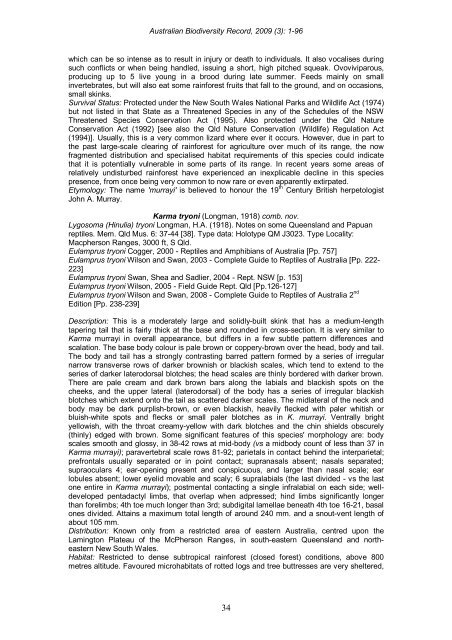AUSTRALIAN BIODIVERSITY RECORD - Calodema
AUSTRALIAN BIODIVERSITY RECORD - Calodema
AUSTRALIAN BIODIVERSITY RECORD - Calodema
You also want an ePaper? Increase the reach of your titles
YUMPU automatically turns print PDFs into web optimized ePapers that Google loves.
Australian Biodiversity Record, 2009 (3): 1-96<br />
which can be so intense as to result in injury or death to individuals. It also vocalises during<br />
such conflicts or when being handled, issuing a short, high pitched squeak. Ovoviviparous,<br />
producing up to 5 live young in a brood during late summer. Feeds mainly on small<br />
invertebrates, but will also eat some rainforest fruits that fall to the ground, and on occasions,<br />
small skinks.<br />
Survival Status: Protected under the New South Wales National Parks and Wildlife Act (1974)<br />
but not listed in that State as a Threatened Species in any of the Schedules of the NSW<br />
Threatened Species Conservation Act (1995). Also protected under the Qld Nature<br />
Conservation Act (1992) [see also the Qld Nature Conservation (Wildlife) Regulation Act<br />
(1994)]. Usually, this is a very common lizard where ever it occurs. However, due in part to<br />
the past large-scale clearing of rainforest for agriculture over much of its range, the now<br />
fragmented distribution and specialised habitat requirements of this species could indicate<br />
that it is potentially vulnerable in some parts of its range. In recent years some areas of<br />
relatively undisturbed rainforest have experienced an inexplicable decline in this species<br />
presence, from once being very common to now rare or even apparently extirpated.<br />
Etymology: The name 'murrayi' is believed to honour the 19 th Century British herpetologist<br />
John A. Murray.<br />
Karma tryoni (Longman, 1918) comb. nov.<br />
Lygosoma (Hinulia) tryoni Longman, H.A. (1918). Notes on some Queensland and Papuan<br />
reptiles. Mem. Qld Mus. 6: 37-44 [38]. Type data: Holotype QM J3023. Type Locality:<br />
Macpherson Ranges, 3000 ft, S Qld.<br />
Eulamprus tryoni Cogger, 2000 - Reptiles and Amphibians of Australia [Pp. 757]<br />
Eulamprus tryoni Wilson and Swan, 2003 - Complete Guide to Reptiles of Australia [Pp. 222-<br />
223]<br />
Eulamprus tryoni Swan, Shea and Sadlier, 2004 - Rept. NSW [p. 153]<br />
Eulamprus tryoni Wilson, 2005 - Field Guide Rept. Qld [Pp.126-127]<br />
Eulamprus tryoni Wilson and Swan, 2008 - Complete Guide to Reptiles of Australia 2 nd<br />
Edition [Pp. 238-239]<br />
Description: This is a moderately large and solidly-built skink that has a medium-length<br />
tapering tail that is fairly thick at the base and rounded in cross-section. It is very similar to<br />
Karma murrayi in overall appearance, but differs in a few subtle pattern differences and<br />
scalation. The base body colour is pale brown or coppery-brown over the head, body and tail.<br />
The body and tail has a strongly contrasting barred pattern formed by a series of irregular<br />
narrow transverse rows of darker brownish or blackish scales, which tend to extend to the<br />
series of darker laterodorsal blotches; the head scales are thinly bordered with darker brown.<br />
There are pale cream and dark brown bars along the labials and blackish spots on the<br />
cheeks, and the upper lateral (laterodorsal) of the body has a series of irregular blackish<br />
blotches which extend onto the tail as scattered darker scales. The midlateral of the neck and<br />
body may be dark purplish-brown, or even blackish, heavily flecked with paler whitish or<br />
bluish-white spots and flecks or small paler blotches as in K. murrayi. Ventrally bright<br />
yellowish, with the throat creamy-yellow with dark blotches and the chin shields obscurely<br />
(thinly) edged with brown. Some significant features of this species' morphology are: body<br />
scales smooth and glossy, in 38-42 rows at mid-body (vs a midbody count of less than 37 in<br />
Karma murrayi); paravertebral scale rows 81-92; parietals in contact behind the interparietal;<br />
prefrontals usually separated or in point contact; supranasals absent; nasals separated;<br />
supraoculars 4; ear-opening present and conspicuous, and larger than nasal scale; ear<br />
lobules absent; lower eyelid movable and scaly; 6 supralabials (the last divided - vs the last<br />
one entire in Karma murrayi); postmental contacting a single infralabial on each side; welldeveloped<br />
pentadactyl limbs, that overlap when adpressed; hind limbs significantly longer<br />
than forelimbs; 4th toe much longer than 3rd; subdigital lamellae beneath 4th toe 16-21, basal<br />
ones divided. Attains a maximum total length of around 240 mm. and a snout-vent length of<br />
about 105 mm.<br />
Distribution: Known only from a restricted area of eastern Australia, centred upon the<br />
Lamington Plateau of the McPherson Ranges, in south-eastern Queensland and northeastern<br />
New South Wales.<br />
Habitat: Restricted to dense subtropical rainforest (closed forest) conditions, above 800<br />
metres altitude. Favoured microhabitats of rotted logs and tree buttresses are very sheltered,<br />
34

















